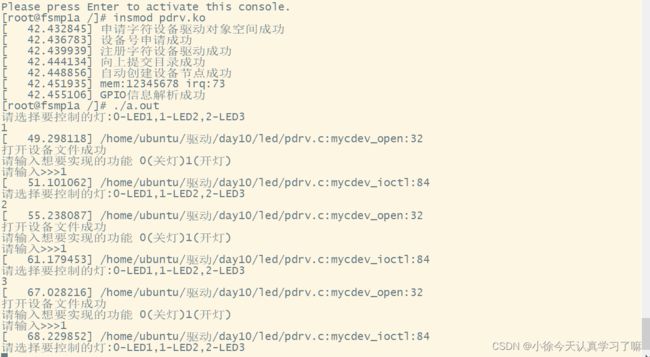注册字符设备使用gpio设备树节点控制led三盏灯的亮灭
设备树:

头文件:
#ifndef __HEAD_H__
#define __HEAD_H__
typedef struct
{
unsigned int MODER;
unsigned int OTYPER;
unsigned int OSPEEDR;
unsigned int PUPDR;
unsigned int IDR;
unsigned int ODR;
} gpio_t;
#define PHY_LED1_ADDR 0X50006000
#define PHY_LED2_ADDR 0X50007000
#define PHY_LED3_ADDR 0X50006000
#define PHY_RCC_ADDR 0X50000A28
// 构建开灯关灯的功能码
#define LED_ON _IOW('l', 1,int)
#define LED_OFF _IOW('l', 0,int)
#endif
驱动程序:
#include
#include
#include
#include
#include
#include
#include
#include
#include
#include
#include
#include
#include
#include
#include "head.h"
struct class *cls;
struct device *dev;
struct resource *res;
unsigned int irqno;
struct device_node *dnode;
struct gpio_desc *gpiono1;
struct gpio_desc *gpiono2;
struct gpio_desc *gpiono3;
struct cdev *cdev;
unsigned int major = 0;
unsigned int minor = 0;
dev_t devno;
int mycdev_open(struct inode *inode, struct file *file)
{
unsigned int min = MINOR(inode->i_rdev); // 获取打开的文件的次设备号
file->private_data = (void *)min;
printk("%s:%s:%d\n", __FILE__, __func__, __LINE__);
return 0;
}
ssize_t mycdev_read(struct file *file, char __user *user, size_t size, loff_t *lof)
{
printk("%s:%s:%d\n", __FILE__, __func__, __LINE__);
return 0;
}
ssize_t mycdev_write(struct file *file, const char __user *user, size_t size, loff_t *lof)
{
printk("%s:%s:%d\n", __FILE__, __func__, __LINE__);
return 0;
}
long mycdev_ioctl(struct file *file, unsigned int cmd, unsigned long arg)
{
int min = (int)file->private_data; // 获取文件的次设备号
switch (min)
{
case 0: // LED1
switch (cmd)
{
case LED_ON: // 开灯
gpiod_set_value(gpiono1, 1);
break;
case LED_OFF: // 关灯
gpiod_set_value(gpiono1, 0);
break;
}
break;
case 1: // LED2
switch (cmd)
{
case LED_ON: // 开灯
gpiod_set_value(gpiono2, 1);
break;
case LED_OFF: // 关灯
gpiod_set_value(gpiono2, 0);
break;
}
break;
case 2: // LED3
switch (cmd)
{
case LED_ON: // 开灯
gpiod_set_value(gpiono3, 1);
break;
case LED_OFF: // 关灯
gpiod_set_value(gpiono3, 0);
break;
}
break;
}
printk("%s:%s:%d\n", __FILE__, __func__, __LINE__);
return 0;
}
int mycdev_close(struct inode *inode, struct file *file)
{
printk("%s:%s:%d\n", __FILE__, __func__, __LINE__);
return 0;
}
struct file_operations fops = {
.open = mycdev_open,
.read = mycdev_read,
.write = mycdev_write,
.release = mycdev_close,
.unlocked_ioctl = mycdev_ioctl,
};
int pdrv_probe(struct platform_device *pdev) // 当驱动和设备匹配成功后执行
{
int ret,
// 1.实例化字符设备驱动对象
cdev = cdev_alloc();
if (cdev == NULL)
{
printk("申请字符设备驱动对象空间失败\n");
ret = -EFAULT;
goto OUT1;
}
printk("申请字符设备驱动对象空间成功\n");
// 2.部分初始化字符设备驱动对象
cdev_init(cdev, &fops);
// 3.申请设备号
if (major == 0) // 动态申请设备号
{
ret = alloc_chrdev_region(&devno, minor, 3, "mycdev");
if (ret)
{
printk("动态申请设备号失败\n");
goto OUT2;
}
major = MAJOR(devno);
minor = MINOR(devno);
}
else // 静态指定设备号
{
ret = register_chrdev_region(devno, 3, "mycdev");
if (ret)
{
printk("静态设备号失败\n");
goto OUT2;
}
}
printk("设备号申请成功\n");
// 4.将字符设备驱动对象注册进内核
ret = cdev_add(cdev, MKDEV(major, minor), 3);
if (ret)
{
printk("注册字符设备驱动失败\n");
goto OUT3;
}
printk("注册字符设备驱动成功\n");
// 5.自动创建设备节点
cls = class_create(THIS_MODULE, "mycdev");
if (IS_ERR(cls))
{
printk("向上提交目录失败\n");
ret = -PTR_ERR(cls);
goto OUT4;
}
printk("向上提交目录成功\n");
// 向上提交设备节点
int i;
for (i = 0; i < 3; i++)
{
dev = device_create(cls, NULL, MKDEV(major, i), NULL, "mycdev%d", i);
if (IS_ERR(dev))
{
printk("向上提交设备信息失败\n");
ret = PTR_ERR(dev);
goto OUT5;
}
}
printk("自动创建设备节点成功\n");
res = platform_get_resource(pdev, IORESOURCE_MEM, 0);
if (res == NULL)
{
printk("解析资源失败%d\n", __LINE__);
return -ENOMEM;
}
irqno = platform_get_irq(pdev, 0);
if (irqno < 0)
{
printk("解析资源失败%d\n", __LINE__);
return -ENOMEM;
}
printk("mem:%x irq:%d\n", res->start, irqno);
// 使用gpio驱动
dnode = of_find_node_by_path("/myplatform");
if (dnode == NULL)
{
printk("解析设备树节点失败\n");
return -ENXIO;
}
// 解析出GPIO编号并申请
gpiono1 = gpiod_get_from_of_node(pdev->dev.of_node, "led1-gpio", 0, GPIOD_OUT_LOW, NULL);
if (IS_ERR(gpiono1))
{
printk("GPIO信息解析失败\n");
return -PTR_ERR(gpiono1);
}
gpiono2 = gpiod_get_from_of_node(pdev->dev.of_node, "led2-gpio", 0, GPIOD_OUT_LOW, NULL);
if (IS_ERR(gpiono2))
{
printk("GPIO信息解析失败\n");
return -PTR_ERR(gpiono2);
}
gpiono3 = gpiod_get_from_of_node(pdev->dev.of_node, "led3-gpio", 0, GPIOD_OUT_LOW, NULL);
if (IS_ERR(gpiono3))
{
printk("GPIO信息解析失败\n");
return -PTR_ERR(gpiono3);
}
/*
gpiod_set_value(gpiono1,1);
gpiod_set_value(gpiono2,1);
gpiod_set_value(gpiono3,1);
*/
printk("GPIO信息解析成功\n");
return 0;
OUT5:
// 释放提交成功的设备节点信息
for (i--; i >= 0; i--)
{
device_destroy(cls, MKDEV(major, i));
}
// 销毁目录
class_destroy(cls);
OUT4:
cdev_del(cdev);
OUT3:
unregister_chrdev_region(MKDEV(major, minor), 3);
OUT2:
kfree(cdev);
OUT1:
return ret;
}
int pdrv_remove(struct platform_device *pdev) // 当设备和驱动分离时执行
{
// 释放GPIO信息
gpiod_put(gpiono1);
gpiod_put(gpiono2);
gpiod_put(gpiono3);
// 销毁节点信息
int i;
for (i = 0; i < 3; i++)
{
device_destroy(cls, MKDEV(major, i));
}
// 销毁目录
class_destroy(cls);
// 注销驱动
unregister_chrdev(major, "mychrdev");
return 0;
}
// 构建设备树匹配表
struct of_device_id oftable[] = {
{
.compatible = "hqyj,myplatform",
},
{
.compatible = "hqyj,myplatform1",
},
{}, // 防止数组越界
};
// 1.分配驱动信息对象
struct platform_driver pdrv = {
.probe = pdrv_probe,
.remove = pdrv_remove,
.driver = {
.name = "bbbbb", // 驱动名
.of_match_table = oftable,
},
};
// 一键注册宏
module_platform_driver(pdrv);
MODULE_LICENSE("GPL");
应用程序:
#include
#include
#include
#include
#include
#include
#include
#include
#include "head.h"
int main(int argc, char const *argv[])
{
int a, b;
int fd;
while (1)
{
// 从中断获取我们想实现的功能功能
printf("请选择要控制的灯:0-LED1,1-LED2,2-LED3\n");
scanf("%d", &a);
switch (a)
{
case 1:
fd = open("/dev/mycdev0", O_RDWR);
break;
case 2:
fd = open("/dev/mycdev1", O_RDWR);
break;
case 3:
fd = open("/dev/mycdev2", O_RDWR);
break;
}
if (fd < 0)
{
printf("打开设备文件失败\n");
return -1;
}
printf("打开设备文件成功\n");
printf("请输入想要实现的功能 ");
printf("0(关灯)1(开灯)\n");
printf("请输入>>>");
scanf("%d", &b);
switch (b)
{
case 1:
ioctl(fd, LED_ON, &b);
break;
case 0:
ioctl(fd, LED_OFF, &b);
break;
}
}
close(fd);
return 0;
}




